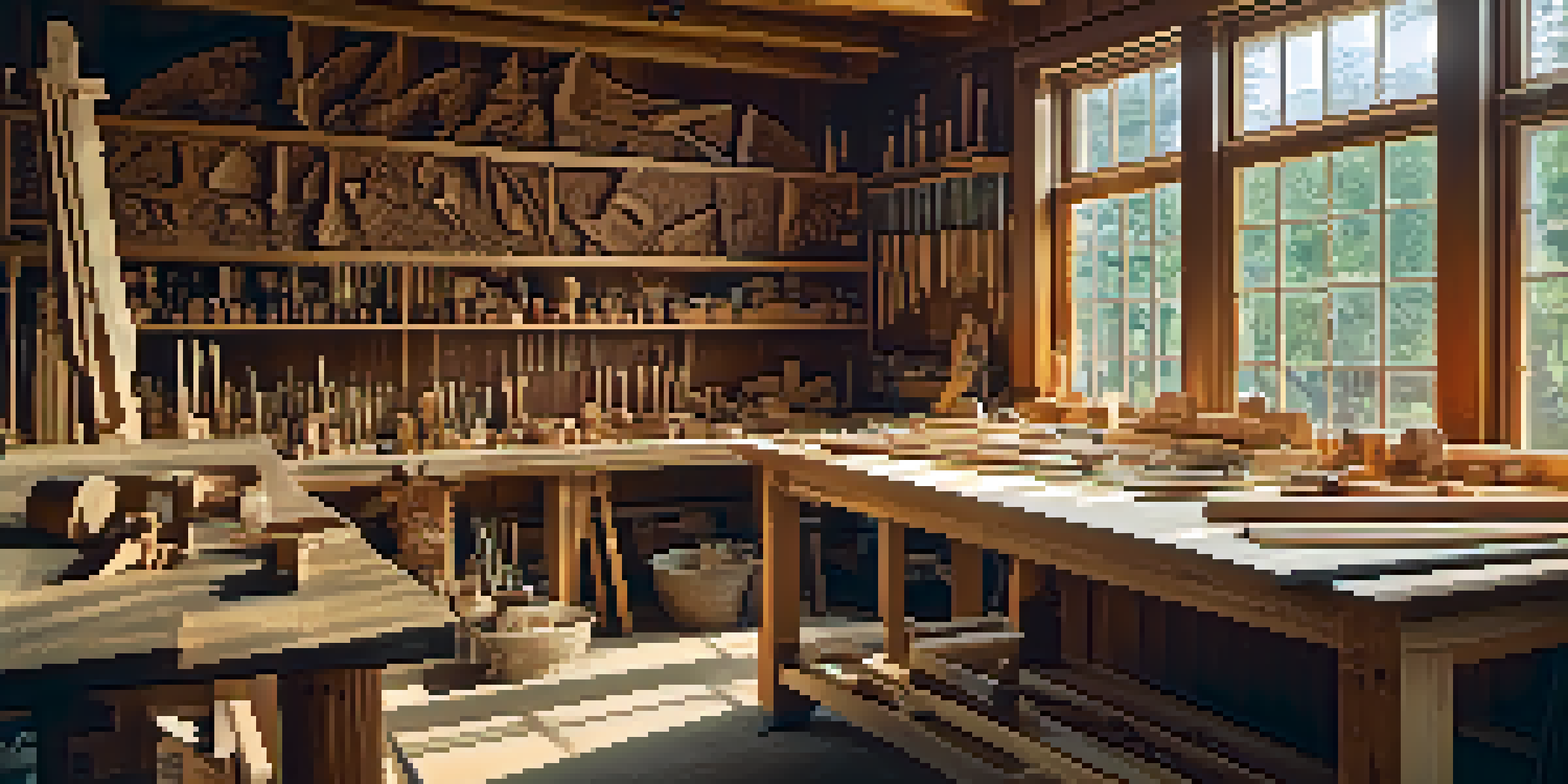Starting Your Carving Business: Essential First Steps

Identify Your Niche: What Will You Carve?
The first step in starting your carving business is to identify your niche. This means determining what specific type of carving you want to focus on, whether it’s wood, stone, or even ice. Your niche will not only dictate the materials you’ll need but also the target audience you’ll cater to.
The only way to do great work is to love what you do.
Consider what excites you the most about carving. If you love working with wood, think about creating custom furniture or intricate sculptures. On the other hand, if stone carving fascinates you, perhaps you could specialize in garden ornaments or memorials.
By honing in on a specific niche, you can tailor your marketing strategies and build a brand identity that resonates with your audience. It’s all about finding that sweet spot where your passion meets market demand.
Develop a Business Plan: Your Roadmap to Success
Once you’ve identified your niche, it’s time to develop a solid business plan. This document will serve as your roadmap, outlining your business goals, target market, and financial projections. Think of it as a blueprint that guides your carving business from conception to reality.

In your business plan, include details about your startup costs, pricing strategies, and marketing approaches. For instance, will you sell your carvings at local craft fairs, online, or through galleries? Knowing your costs and potential revenue can help you make informed decisions down the line.
Identify Your Carving Niche
Determine the specific type of carving you want to focus on to connect with your target audience.
Moreover, a well-thought-out business plan can be crucial if you decide to seek funding or investors. It demonstrates that you’ve done your homework and are committed to making your carving business a success.
Set Up Your Workspace: Where the Magic Happens
Creating an efficient workspace is crucial for your carving business. Whether you have a dedicated studio or a small corner in your garage, ensure it’s organized and conducive to creativity. A clutter-free environment can significantly enhance your focus and productivity.
Planning is bringing the future into the present so that you can do something about it now.
Consider the tools and equipment you’ll need for your carving projects. Quality tools can make a world of difference in your work, so invest in items that will last. Don’t forget to include safety gear, as carving can be dangerous without proper precautions.
Light is also an essential factor in your workspace. Good lighting not only helps you see your work clearly but also prevents strain on your eyes. By setting up a comfortable and functional space, you’ll be more inspired to create!
Source Materials: Finding Quality and Affordable Supplies
Finding the right materials for your carving projects is vital. Research local suppliers, online marketplaces, and even salvage yards to source quality wood, stone, or other materials at affordable prices. Building relationships with suppliers can also lead to discounts or exclusive deals.
Consider experimenting with different types of materials to see what resonates best with your artistic style. For instance, if you're working with wood, you might find that certain species like cherry or walnut lend themselves better to intricate details.
Develop a Solid Business Plan
Create a comprehensive business plan that outlines your goals, costs, and marketing strategies for success.
Don’t forget to budget for your materials. Keeping track of your expenses will help you manage your finances and ensure that your business remains profitable as you grow.
Create a Portfolio: Showcasing Your Unique Style
An essential step in establishing your carving business is creating a portfolio. This is where you can showcase your best work and demonstrate your unique style to potential customers. A well-curated portfolio acts as a visual resume that highlights your skills and creativity.
Consider photographing your carvings in different settings to give clients an idea of how they might fit into their homes or businesses. High-quality images can make a significant impact, so invest some time in learning basic photography skills or consider hiring a professional.
Your portfolio can also be a powerful marketing tool. Whether you’re applying for exhibitions, selling online, or reaching out to galleries, having a strong portfolio will help you stand out in the competitive carving market.
Establish an Online Presence: Going Digital
In today’s digital age, having an online presence is crucial for any business, including your carving venture. Start by creating a website that showcases your portfolio, shares your story, and includes an easy way for customers to contact you. A well-designed website can serve as your business's online hub.
Social media platforms like Instagram and Facebook are also excellent for promoting your carvings. Share behind-the-scenes glimpses of your work process, engage with followers, and showcase finished pieces to build a loyal community around your art.
Establish an Online Presence
Build a website and utilize social media to effectively showcase your work and connect with potential customers.
Remember, engaging content is key to attracting and retaining customers online. By sharing your passion for carving and connecting with your audience, you’ll create a supportive fan base that can help propel your business forward.
Market Your Business: Spreading the Word
Once your carving business is set up, it’s time to spread the word. Utilize both online and offline marketing strategies to reach your audience effectively. Attend local art shows and craft fairs, where you can showcase your work and network with potential clients.
Online marketing can include social media ads, email newsletters, and search engine optimization (SEO) techniques to help your website rank higher in search results. Using relevant keywords related to carving can increase your visibility and draw in more customers.

Don’t underestimate the power of word-of-mouth marketing. Encourage satisfied customers to share their experiences and recommend your work to others. Building a community around your carving business can lead to loyal customers and repeat business.